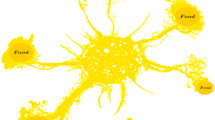Abstract
An improved differential evolutionary cement mill operation index decision algorithm based on constraint control and selection strategy is proposed to address the problem that the operation index is usually decided by manual experience in the cement mill operation process, which causes unqualified cement specific surface area and excessive cement mill power consumption. The algorithm uses an improved differential evolutionary algorithm to solve the long short-term memory network (LSTM) power consumption prediction model and specific surface area prediction model based on PCA and XGBoost. Constraints are set in the solution process to obtain the optimal solution that satisfies the quality index and the power consumption index. The optimal solution is used to guide the scheduling of each piece of equipment in the production process and to make decisions on the operating index of the cement mill grinding process so that the specific surface area is qualified and the power consumption is reduced.













Similar content being viewed by others
REFERENCES
Wurzinger, A., Leibinger, H., Jakubek, S., and Kozek, M., Data-driven modeling and nonlinear model predictive control design for a rotary cement kiln, IFAC-PapersOnLine, 2019, vol. 52, no. 16, pp. 759–764. https://doi.org/10.1016/j.ifacol.2019.12.054
Genc, Ö., Optimization of a fully air-swept dry grinding cement raw meal ball mill closed circuit capacity with the aid of simulation, Miner. Eng., 2015, vol. 74, pp. 41–50. https://doi.org/10.1016/j.mineng.2015.01.006
Altun, O., Energy and cement quality optimization of a cement grinding circuit, Adv. Powder Technol., 2018, vol. 29, no. 7, pp. 1713–1723. https://doi.org/10.1016/j.apt.2018.04.006
Liu, J., Wang, Yu., and Zhang, Yo., A novel isomap-SVR soft sensor model and its application in rotary kiln calcination zone temperature prediction, Symmetry, 2020, vol. 12, no. 1, p. 167. https://doi.org/10.3390/sym12010167
Li, T., Zhang, Zh., and Chen, H., Predicting the combustion state of rotary kilns using a convolutional recurrent neural network, J. Process Control, 2019, vol. 84, pp. 207–214. https://doi.org/10.1016/j.jprocont.2019.10.009
Ma, J.X., Modeling and adaptive real-time optimization of hydrometallurgy cyanidation leaching process, PhD Dissertation, Shenyang: Northeastern Univ., 2015.
Gu, W.J., Modeling and operation of real-time optimization of C2 hydrogenation reactor, Green Pet. Petrochem., 2019, no. 5, pp. 14–21.
Zhong, W.M., Qi, R.B., Du, W.L., et al., Research progress on operation optimization of chemical process, Chem. React. Eng. Technol., 2014, vol. 30, no. 3, pp. 281–288.
Pan, Y., Intelligent control of power plant SCR flue gas denitration system based on mechanism modeling, PhD Dissertation, Beijing: North China Electric Power Univ., 2015.
Hong, J.H., Mechanism modeling and parameter optimization of high-efficiency double-turret ultrathin chip transferring process, PhD Dissertation, Wuhan, China: Huazhong Univ. of Science and Technology, 2018.
Xie, W.M., Li, J., Zhou, F.P., et al., Power consumption prediction of sewage treatment plant based on BP neural network and genetic algorithm, Water Resour. Power, 2018, vol. 36, no. 8, pp. 202–204.
Li, J.N., Gao, X.Z., Chai, T.Y., et al., Data-driven operational optimization control of industrial processes, Control Theory Appl., 2016, vol. 33, no. 12, pp. 1584–1592.
Cao, B.F., Xie, Y.F., Yang, C.H., et al., Integrated modeling for production index of bauxite flotation based on multi-source data, Control Theory Appl., 2014, vol. 31, no. 9, pp. 1252–1261.
Dai, W., Wang, X.W., Lu, X.L., et al., Case-based reasoning and reinforcement learning integrated set-point optimization method for grinding process, Control Theory Appl., 2019, vol. 36, no. 1, pp. 53–64.
Wang, H.Y., Research on energy consumption prediction of forging line based on support vector machine, PhD Dissertation, Jinan, China: Shandong Univ., 2017.
Ding, J.L., Research on optimal decision-making of operational indices of beneficiation process under dynamic environment, PhD Dissertation, Shenyang, China: Northeastern Univ., 2012.
Hu, H.Z., Research on optimal and control of the process in new dry cement production, PhD Dissertation, Hangzhou, China: Zhenjiang Univ., 2012.
Wu, M.S., Yuan, Z.G., and Zhang, Q., Modeling of the combined grinding system based on the cement particle size mode template, Control Eng. China, 2016, vol. 23, no. 9, pp. 1343–1348.
Wang, G.S., The specific surface area of cement was rapidly predicted by linear regression with a fineness of 45 um, Sichuan Cement, 2008, no. 2, pp. 50–51.
Krundyshev, V.M., Identification of cyber threats in networks of industrial internet of things based on neural network methods using memory, Autom. Control Comput. Sci., 2020, vol. 54, no. 8, pp. 900–906. doi https://doi.org/10.3103/S0146411620080180
Pchelkin, A.A. and Borisov, A.N., On the sensitivity of the neural network implementing the principal component analysis method, Autom. Control Comput. Sci., 2009, vol. 43, no. 4, pp. 195–202. https://doi.org/10.3103/S0146411609040051
Lim, S. and Chi, S., XGBoost application on bridge management systems for proactive damage estimation, Adv. Eng. Inf., 2019, vol. 41, p. 100922. https://doi.org/10.1016/j.aei.2019.100922
Shi, X., Sun. Q., Ji, Ya., Xu, Q., Yang, X., and Hao, X., Predictive control research for cement burning system using two-cycle coupling optimization, Expert Syst. Appl., 2021, vol. 191, p. 116259. https://doi.org/10.1016/j.eswa.2021.116259
Funding
This work was supported by the National Natural Science Foundation of China (grant no. 62073281), the Hebei Provincial Natural Science Foundation (grant no. F2019203385), the Hebei Provincial Science and Technology Plan Project (grant no. 19211602D), the Second Batch of Youth Top-notch Talent Support Program in Hebei Province (grant no. 5040050).
Author information
Authors and Affiliations
Corresponding author
Ethics declarations
The authors declare that they have no conflicts of interest.
About this article
Cite this article
Chong Liu, Yang, X., Zheng, L. et al. The Decision Algorithm of Cement Mill Operation Index Based on Improved Differential Evolution Algorithm. Aut. Control Comp. Sci. 56, 533–545 (2022). https://doi.org/10.3103/S0146411622060049
Received:
Revised:
Accepted:
Published:
Issue Date:
DOI: https://doi.org/10.3103/S0146411622060049




